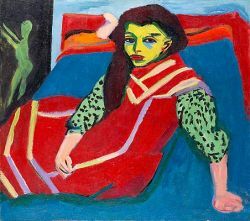 Expressionism was an avant-garde artistic movement in opposition to French impressionism.
Expressionism was an avant-garde artistic movement in opposition to French impressionism.
The idea of expressionism was of art as action, in the artist's conception of the image in a way emotional, visceral, sometimes violent, in which colors and shapes do not correspond to reality direct.
The concept was first used by Herwath Walden in his magazine “Der Sturm” (The Storm) in 1912. It took place mainly in Germany, so it can also be called German expressionism, and was influenced by the primitive art of the African tribes.
The works rescued a bias of social criticism inserted in the arts, with everyday scenes portrayed without no restraint on the artist's part, dramatized, with many themed series about sex and death.
The expressionists acted in opposition to the idea of impression of the world promoted by impressionists like Claude Monet, of the ethereal nature illustrated by the artist.
The origins of expressionism references are given by the works of Van Gogh and Edvard Munch, artists who already used distortions and a strong emotional charge.
See too:
- Cubism
- Surrealism
- Dadaism
- futurism
- abstractionism
- The Types of Art
Characteristics of Expressionism
- art as action
- rejection of the impression of the world
- Use of distorted and thick lines
- Author's Emotional and Subjective Expression
- Radical Simplification of Forms
- Use of strong colors
- Intensity of paint and brush on canvas
Learn more about characteristics of expressionism.
Top Artists of Expressionism
Expressionist artists were divided into two groups:
Die Brucke (The Bridge)
Influenced by Van Gogh, Gauguin, Matisse. The group consisted of Ernst Ludwig Kirchner, Erich Heckel, Karl Schmidt-Rottluff, Fritz Bleyl, Emil Nolde, Max Pechstein and Otto Mueller.
Der Blaue Reiter (The Blue Knight)
Influenced by Kandinsky, they used more subtle tones and their themes were around spirituality. The group included artists Max Beckmann, Käthe Kollwitz, Ernst Barlach and Wilhelm Lehmbruck.
Abstract Expressionism
A strand of Expressionism, it emerged in New York in the mid-twentieth century, right after World War II. The post-war period made the United States a new artistic center, and this union of creatives gave rise to movements such as Abstract Expressionism. Arshile Gorky, an Armenian painter who emigrated to New York, pioneered the style. Followed by names like Jackson Pollock, Willem de Kooning and Isamu Noguchi.
Abstract expressionism was motivated by the denial of traditional techniques, and they took a critical stance in relation to society, dialoguing with the vanguards in the fields of psychology, anthropology, literature, music and movie theater.
Expressionism in Brazil
The main name of expressionism in Brazil was Anita Malfatti, who introduced the European artistic vanguards to Brazilian circles. We can also mention Lasar Segall, Oswaldo Goeldi, Flávio de Carvalho and Iberê Camargo.
See too: Vanguard and Modern Art.


